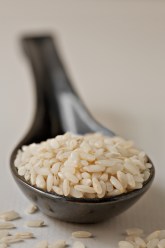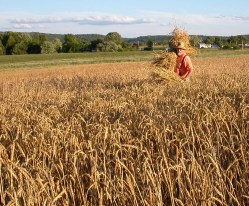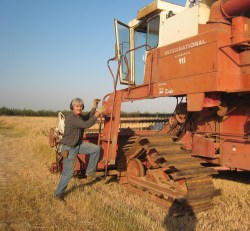
Carolina Gold Rice from Anson Mills.
Community-supported agriculture (CSA) households know the cries.
“So many sweet potatoes!”
“Tomatillos again?”
But “Oh, man — more whole wheat flour!”? Not so much. Yet that may be coming.
On the East Coast, Virginia’s Moutoux Orchards is growing and milling wheat and barley to nestle beside produce, dairy, eggs, and meat in its Full Diet CSA. To the west, Windborne Farm of northern California offers a grain CSA featuring not just wheat and barley, but also rare grains like teff and millet raised using a pair of draft horses.
All over the country, small grain farmers like these may soon place the last piece in the local-foods puzzle.
There is no question that fruits and vegetables have been the backbone of the locavore movement. The number of farmers markets in the U.S. has increased 400 percent since 1994, while CSAs grew from a handful in the 1980s to an estimated 6,500 today. Eggs, meat, fish, and dairy have joined produce in market stalls and CSA boxes, but grains often lag behind.
“There are more small grain growers than a decade ago, but [the] trend here is growing quite slowly and is far behind small-scale produce, meat, and dairy growers,” says Erin Barnett, head of the local food directory Local Harvest. Out of more than 18,600 small farms listed on the website, fewer than 600 grow wheat, and an even smaller number offer oats or rye.
For generations, large-scale agribusiness has been seen as the most efficient way to produce commodity grains, such as corn, wheat, and rice (a fact that may be changing thanks to climate change). Big Midwestern farms churn out enough to feed every American 8.2 servings of grain a day. Farm subsidies (and, increasingly, crop insurance) have also given large farms an advantage for years. Buoyed by this system, large farmers and processors can grow grains at a price much lower than small producers can even imagine.
But as Big Grain has taken over, the variety of seeds available and the wisdom about growing grains sustainably have diminished. Until recently. Now some small-scale grain farmers have stepped back into the fray. They approach it not as direct competitors to commodity grain growers, but as an alternative for eaters in search of healthier, more sustainable options. Such producers claim a corner of the market with sustainable growing methods, value-added products, or specialty crops that customers choose for flavor. In fact, most successful local-scale grain farming relies on all three.

Photo by Elizabeth Dyck.
A new wheatail market
“This is the absolute opposite of large farming systems,” says Eli Rogosa, who grows grain for seeds and retail in western Massachusetts, and who directs the Heritage Grain Conservancy and coordinates the Northeast Organic Wheat initiative, funded by Sustainable Agriculture Research and Education.
Most small grain growers just got rolling in the past 15 years, but already consumers are smitten. A gluten-sensitive customer of Rogosa raves about an ancient wheat so pure and free of the allergenic protein that she could eat pita again. Grass Valley Grains of northern California ships whole wheat flour to a customer in Waikiki who will bake with nothing else. A San Francisco chef has gushed over cornmeal from South Carolina’s Anson Mills that “made love to buttermilk.” And the Moutoux Orchards CSA? It sold out with its 2011 debut — even with a price tag of $250 per person per month.
“There is a growing contingent of people who put a lot of importance on food quality and safety,” explained Mark Sorrells, chair of the Department of Plant Breeding and Genetics at Cornell University. “Also, people want to support local economies and businesses that give back to the community.”
Before farmers can add grain to the local foods picture, farmers have to address some problems unique to these crops. That is where people like Ragosa and Sorrells come in.
For one, thanks to industrial agriculture, the array of available seeds has been winnowed down to very few varieties. And most of these varieties are patented. “This is a global, silent crisis of loss of biodiversity,” says Rogosa. And that biodiversity has only gained in importance as farmers face the increasingly brutal results of climate change.
For Rogosa, farmer-saved seeds — also known as “landrace” seeds — offer economic benefits as well. “Unique varieties help small-scale farmers earn a living and have a niche market,” she says.
Sorrells is focusing on farming wisdom. He noticed a problem when retailers like New York City’s Greenmarket reported that local grain was flying out of market stalls faster than they could stock them. Simply put, Sorrells says, “they can’t produce enough to meet demand.”
Sorrells and Cornell post-doc Julie Dawson started to talk to growers and organizations like the Organic Growers’ Research and Information-Sharing Network and the Northeast Organic Farming Association of New York. Across the region, farmers found that growing local, organic grain posed unique challenges. Three of the biggest challenges were identifying the hardiest varieties, finding enough seeds to fill their fields, and managing their grain crops organically.
The scientists are now working, in part, to find the best seeds in the right quantity, as well as improve knowledge about management — the side of farming focused on fertilization, density of seed planting, and combating pests.
Grains as food, not filler

Reed Hamilton of Grass Valley Grains on a tractor.
Another challenge stems from the price factor. Once grain farmers supply specialty markets, they have to face the same reality as all local producers — namely that mainstream consumers balk at the price of most of small-scale, sustainably produced foods. While seasonal herbs or vegetables can compete with supermarket prices, shoppers are unlikely to find local flour below $1.25 to $2 per pound.
Perhaps the biggest problem, though, lies in the food system itself. To truly fix grain production, Americans must change the way they farm and eat in a number of ways.
For one, says Glenn Roberts of Anson Mills, we may have to eat more actual grain ourselves. “Ninety-plus percent of all the grain grown in North Carolina goes into the mouths of animals,” Roberts says. “It doesn’t actually [feed] people.” If we return to the model used by beloved agriculture pioneer Thomas Jefferson, who saw meat as a condiment, then local grains might sound more affordable. When we see grains not just as cheap fillers, but as unique foods, they become worth a little more investment — both of our money and our culinary attention.
We also have to recognize the power of landrace species. Roberts, who has started giving farmers grants to test such seeds, confirms that they are hardy enough to stand up to erratic weather. “They adapt, that’s what they do,” he says proudly.
And finally, research must appeal to large funders just as much as rogue researchers. This has already begun. Monsanto may not shell out for heritage seed testing any time soon, but the USDA has supported Rogosa’s trials and the research at Cornell.
Will we ever see local grain production scale up like meat and produce have? The next few years will tell. What is certain is that the small-grain influx has refreshed the idea that growers, scientists, and consumers can all play a role in tackling established behemoths and move into a new frontier.




